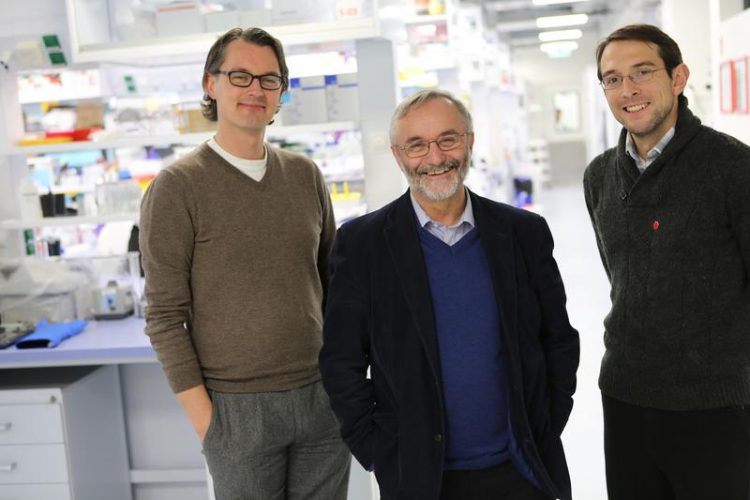LCSB coordinates European project on Parkinson’s research

From left: Prof. Jens Schwamborn (head of the LCSB group Development and Cell Biology), Prof. Rudi Balling (LCSB director and coordinator of SysMedPD) und Dr Ronan Fleming (Systems Biochemist scienceRELATIONS / Universität Luxemburg
With this funding, they will be developing novel techniques by which to identify and research into active compounds against PD. They will furthermore be advancing drug candidates towards their medical application.
“Universities and biopharmaceutical companies complement each other’s expertise ideally in SysMedPD,” says Prof. Rudi Balling, LCSB director and coordinator of SysMedPD. “This creates optimal conditions in which to progress a good deal further in developing diagnoses and therapies for Parkinson’s disease.”
Parkinson’s disease is a gradually progressive disease of human nerve tissue, resulting among other things in muscle tremors and muscle rigidity. The mitochondria of nerve cells are often causally involved in the onset – mitochondria being the power plants of cells, in which biochemical reactions provide energy for cellular metabolic processes.
“We estimate that in about ten to twenty percent of all Parkinson’s patients, their mitochondria do not function properly,” says senior LCSB scientist Dr Ronan Fleming, who is significantly involved in the conception and coordination of SysMedPD. “In order to better diagnose, heal or at least effectively curb the progression of Parkinson’s disease, we must understand this dysfunction of mitochondria in detail.”
The researchers within SysMedPD are first concentrating on such patterns of PD in which the mitochondria are damaged by mutations in individual genes. “Later, the results can then be carried over to patient groups in which multiple genes and environmental factors are involved in the onset of PD,” adds Dr Fleming.
The SysMedPD consortium will tackle this task with different approaches: “At the LCSB, we place emphasis on developing new, computational models by which we can better depict the processes going on inside mitochondria,” Ronan Fleming says. Prof. Jens Schwamborn, head of the LCSB group Development and Cell Biology, describes a complementary approach: “We must verify any computational predictions using experiments. Therefore, in the scope of this EU project, we will also employ advanced cellular models, where skin samples obtained from Parkinson’s disease patients are reprogrammed into living human nerve cells.”
To ensure the research results obtained within SysMedPD are translated into application as quickly as possible, the consortium also has biopharmaceutical companies on board. Their areas of involvement are test development for new active compounds and identification of active compounds.
“The project is organised such that the insights that we and the other academic partners gain will complement those of the companies involved very well,” says Prof. Rudi Balling. “With this close connection between public and private research, we can ensure the EU funding, firstly, is employed optimally in the interest of the PD patients and, secondly, will generate economic stimuli. These are important objectives of the EU that we will fulfil here.”
The SysMedPD partners:
– Germany: University of Lübeck (Prof. Christine Klein), EURICE – European Research and Project Office GmbH (Corinna Hahn)
– Ireland: Maynooth University (Dr Niall Finnerty)
– Luxembourg: University of Luxembourg (Prof. Rudi Balling, Dr Ronan Fleming, Prof. Jens Schwamborn)
– Netherlands: Leiden University (Prof. Thomas Hankemeier), Khondrion BV (Prof. Jan Smeitink), Mimetas BV (Dr Paul Vulto)
– Great Britain: University College London (Prof. Anthony Schapira)
http://www.uni.lu/lcsb – Homepage of the Luxembourg Centre for Systems Biomedicine
Media Contact
All latest news from the category: Health and Medicine
This subject area encompasses research and studies in the field of human medicine.
Among the wide-ranging list of topics covered here are anesthesiology, anatomy, surgery, human genetics, hygiene and environmental medicine, internal medicine, neurology, pharmacology, physiology, urology and dental medicine.
Newest articles

NASA: Mystery of life’s handedness deepens
The mystery of why life uses molecules with specific orientations has deepened with a NASA-funded discovery that RNA — a key molecule thought to have potentially held the instructions for…

What are the effects of historic lithium mining on water quality?
Study reveals low levels of common contaminants but high levels of other elements in waters associated with an abandoned lithium mine. Lithium ore and mining waste from a historic lithium…

Quantum-inspired design boosts efficiency of heat-to-electricity conversion
Rice engineers take unconventional route to improving thermophotovoltaic systems. Researchers at Rice University have found a new way to improve a key element of thermophotovoltaic (TPV) systems, which convert heat…



